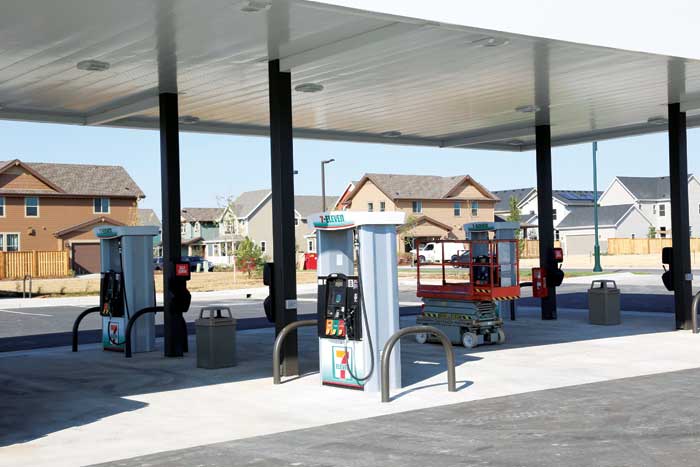
This perspective of the new 7-Eleven on Northfield Blvd., shot with a 55ml lens to show the human-eye view, accurately shows the distance between gas pumps and homes.
Our neighbors are concerned about a big box gas station being planned in Stapleton’s Eastbridge neighborhood. Friends living near the new gas station in Northfield have expressed similar worries. Will these stations be a toxic death-knell for residents? Or are they safe?
One thing’s for certain—gas stations are ubiquitous.
That’s because we need ’em. They’re convenient, allow us to be mobile, and provide stuff we use. Often they’re economical and employ locals. From a corporate standpoint, they’re efficient, profitable, and great lures for opportunistic shoppers. Witness the unbundling of gas stations from service shops, and their pairing with mini-marts and big-box stores.
Can gas stations be a nuisance? Sure—by altering the traffic and character of a neighborhood.
Fortunately, in newer neighborhoods they’re often sited with intent. Thus, in adjacent residential areas, such stations don’t typically have a major impact on a neighborhood’s character, nor do they markedly impact crime, litter, noise, pollution or property values.
But on-site, the story is different. Compared to residences or many other commercial establishments, gas stations and their convenience stores experience more frequent fires, pedestrian and vehicle collisions, and “crimes of opportunity” like theft. Fortunately, some of their typical hazards, like gasoline spills, are increasingly mitigated by technology. For example, modern fuel nozzles automatically shut off when an unattended pump begins to spill. And when you drive off with the nozzle still attached to your minivan—the hose will automatically disconnect from the island and shut down. I guess that means that in Die Hard 7, Bruce Willis will have to blow up the gas station in some other way.
Unfortunately, gas stations also have long-term offsite impacts. That’s because gasoline, like paint and glue, contains a veritable xylophone of toxic ingredients such as benzene, toluene and xylene. These compounds, when breathed at low concentrations, aren’t usually acutely harmful, but do have significant long-term impacts on our health.
In older gas stations, rusting or leaky storage tanks and pipes allowed gas to seep into soils and drinking water, permitting these contaminants to impact public health. Although we’re still cleaning up the legacy of older stations, since 2009 new fuel tanks, pipes and pump areas in Colorado are double-lined, and are regularly monitored by state agencies to make sure they are maintained and safe.
Of more concern is the evaporation of gas’ noxious ingredients. In bygone times they’d waft away, carefree. They got released during fueling, during warming and depressurization of gasoline from underground tanks, and by displacement of vapor-ridden air when new fuel was added to empty gasoline storage tanks. Fortunately, all Colorado gas stations now capture these vapors. Moreover, newer passenger cars have onboard vapor recovery systems to help curb fumes emitted during refilling, and tanker trucks use a special hose to capture displaced vapors while refilling underground tanks.
But such devices don’t catch all the fumes, which also emanate from evaporating or dripped gas, from idling engines, from unsealed tanks on older cars, and from tanker trucks whose drivers bypass vapor recovery systems to speed up fuel transfers. The net result is that every gas station is like an invisible smokestack. Its vapor plume extends across adjacent roads and neighborhoods. The plume’s vapors dissipate naturally in wind and sunlight, but in urban settings they can impact indoor air quality in nearby homes.
The size, distribution and concentration of these airborne plumes are governed by how busy the gas station is, and environmental factors like wind and temperature. These factors in turn affect health risks of adjacent residents.
In some cities, stations are set back 50’ to 300’ from residences to allow the fumes to dissipate before encountering homes—but elsewhere these stations abut residential property. In part, this variation in urban setback standards is because there often isn’t a 100 percent “safe” distance away, because gas station vapors are often compounded by hazardous fumes that emanate from nearby road traffic or other sources. And in part, it’s because there is little population-scale epidemiological data on people living near gas stations in the U.S. Finally, every site’s environmental conditions are different, and although it is straightforward to measure and model such conditions to minimize risk on adjacent properties, such work is expensive and not typically done.
As Colorado’s economy continues to boom, gas stations will keep sprouting up. There’s even one being installed in my favorite end-of-the-line mountain town—Dotsero. But given how little we know about the offsite air impacts of such stations in Colorado, it might be wise to examine such gassy growth with care. At least until electric cars make gas stations obsolete.
James Hagadorn, Ph.D., is a scientist at the Denver Museum of Nature & Science. Suggestions and comments are welcome at jwhagadorn@dmns.org.




0 Comments